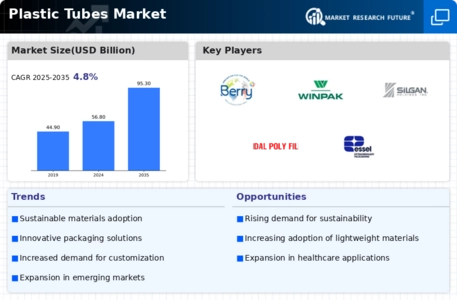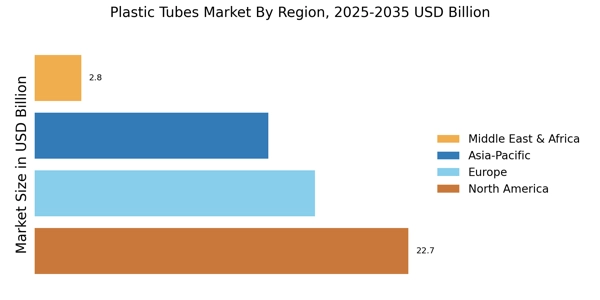Rising Demand in Packaging Sector
The increasing demand for lightweight and durable packaging solutions is a primary driver for the Plastic Tubes Market. As consumer preferences shift towards convenience and sustainability, manufacturers are increasingly adopting plastic tubes for packaging various products, including cosmetics, pharmaceuticals, and food items. The packaging sector is projected to grow at a compound annual growth rate of approximately 4.5%, which directly influences the demand for plastic tubes. This trend is further supported by the need for efficient storage and transportation, as plastic tubes offer protection against contamination and damage. Consequently, the Plastic Tubes Market is likely to experience substantial growth as companies seek innovative packaging solutions that align with consumer expectations.
Increasing Focus on Sustainability
The growing emphasis on sustainability is reshaping the Plastic Tubes Market. Consumers are becoming more environmentally conscious, prompting manufacturers to explore eco-friendly materials and production methods. The shift towards biodegradable and recyclable plastic tubes is gaining traction, as companies strive to reduce their carbon footprint. This trend is supported by regulatory pressures and consumer demand for sustainable products. As a result, the Plastic Tubes Market is likely to see an increase in the adoption of sustainable practices, which could enhance brand loyalty and attract environmentally aware consumers. This focus on sustainability may also lead to innovations in material science, further driving the market.
Growth in Personal Care and Cosmetics
The personal care and cosmetics industry is witnessing a robust expansion, which significantly impacts the Plastic Tubes Market. With an increasing number of brands entering the market, the demand for aesthetically pleasing and functional packaging is on the rise. Plastic tubes are favored for their versatility, allowing for various designs and sizes that cater to diverse consumer needs. The market for personal care products is expected to reach a valuation of over 500 billion dollars by 2025, indicating a strong correlation with the growth of plastic tubes. This trend suggests that as the personal care sector continues to flourish, the Plastic Tubes Market will likely benefit from heightened demand for innovative packaging solutions.
Expansion of the Pharmaceutical Sector
The pharmaceutical sector is experiencing significant growth, which is positively influencing the Plastic Tubes Market. With an increasing number of pharmaceutical products requiring effective packaging solutions, plastic tubes are becoming a preferred choice due to their ability to maintain product integrity and extend shelf life. The pharmaceutical packaging market is projected to grow at a rate of around 5% annually, driven by the need for safe and efficient delivery of medications. This growth in the pharmaceutical sector suggests that the demand for plastic tubes will likely rise, as manufacturers seek reliable packaging options that comply with stringent regulatory standards. Consequently, the Plastic Tubes Market stands to benefit from this expansion.
Technological Innovations in Manufacturing
Technological advancements in manufacturing processes are transforming the Plastic Tubes Market. Innovations such as 3D printing and automation are enhancing production efficiency and reducing costs. These technologies enable manufacturers to produce customized plastic tubes that meet specific client requirements, thereby expanding their market reach. Furthermore, the integration of smart technologies in production lines is expected to improve quality control and reduce waste, which is increasingly important in today's environmentally conscious market. As these technological innovations continue to evolve, they are likely to drive growth in the Plastic Tubes Market, allowing companies to respond more effectively to changing consumer demands.


















Leave a Comment